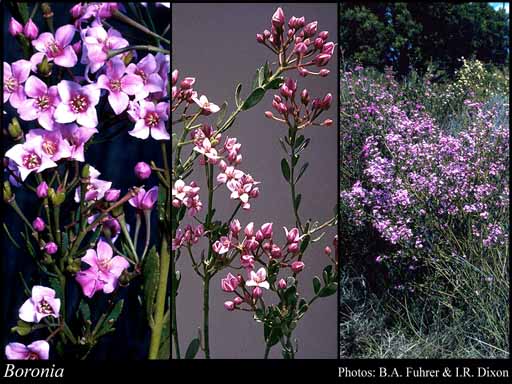- Reference
- Tracts Nat.Hist. 288, t. 4-7 (1798)
- Name Status
- Current







Scientific Description
Family Rutaceae.
Habit and leaf form. Shrubs, or herbs; evergreen, or deciduous; bearing essential oils. Perennial. Young stems branchlets with continuous, non-articulated cortex. Mesophytic, or xerophytic. Leaves opposite, or alternate (very rarely); leathery, or ‘herbaceous’; petiolate; non-sheathing; gland-dotted; aromatic; simple, or compound; pinnate, or bipinnate. Leaf blades when simple dissected, or entire; when simple/dissected pinnatifid, or much-divided; pinnately veined, or one-veined. Leaves without stipules, or with stipules; without a persistent basal meristem. Leaf anatomy. Hairs present, or absent; complex hairs present, or absent (then trichomes simple). Complex hairs stellate. Stem anatomy. Nodes unilacunar, or tri-lacunar. Secondary thickening developing from a conventional cambial ring.
Reproductive type, pollination. Fertile flowers hermaphrodite. Unisexual flowers absent. Plants hermaphrodite. Entomophilous.
Inflorescence and flower features. Flowers solitary, or aggregated in ‘inflorescences’; when solitary, axillary; in cymes. The terminal inflorescence unit cymose, or racemose. Inflorescences terminal. Flowers bracteate; bi- bracteolate; small to medium-sized; commonly fragrant; regular, or somewhat irregular. The floral asymmetry when noticeable, involving the perianth and involving the androecium (not K). Flowers 4(–5) merous; cyclic. Floral receptacle developing a gynophore (associated with the disk), or with neither androphore nor gynophore. Free hypanthium absent. Hypogynous disk present (prominent); intrastaminal; annular (sometimes one-sided), or of separate members. Perianth with distinct calyx and corolla; 8, or 10; 2 -whorled; isomerous. Calyx 4(–5); 1 -whorled; polysepalous; imbricate, or valvate; regular; persistent, or not persistent; with the median member posterior. Corolla 4(–5); 1 -whorled; polypetalous; imbricate, or valvate; regular, or unequal but not bilabiate. Androecium 8 (inserted beneath disc). Androecial members free of the perianth; all equal, or markedly unequal; free of one another, or coherent; 1 -whorled, or 2 -whorled. Androecium exclusively of fertile stamens, or including staminodes. Staminodes when present, 4. Stamens 4, or 8; isomerous with the perianth, or diplostemonous; alternisepalous, or oppositisepalous (? when the outer whorl lost). Filaments glabrous, or hairy; non-petaloid; inwardly curved, often enlarged at apex and often with a subapical inflexed tip. Anthers dorsifixed, or basifixed; versatile; dehiscing via longitudinal slits; introrse; tetrasporangiate; appendaged; minutely or prominently white- apiculate. Gynoecium 4 carpelled. The pistil 4 celled. Gynoecium syncarpous (carpels free, united at apex on adaxial margin by the style); synstylous; superior. Ovary plurilocular; 4 locular. Gynoecium stylate. Styles 1; apical (styles affixed near apex of inner margin of carpels). Stigmas wet type, or dry type; papillate, or non-papillate; Group II type, or Group IV type. Placentation axile. Ovules 1–5(–50) per locule; pendulous to ascending; epitropous; collateral, or superposed, or biseriate; arillate, or non-arillate; anatropous, or hemianatropous.
Fruit and seed features. Fruit fleshy, or non-fleshy; dehiscent, or indehiscent, or a schizocarp. Mericarps when schizocarpic, comprising berrylets, or comprising follicles, or comprising nutlets, or comprising drupelets. Fruit when syncarpous and non-schizocarpic, a berry, or a drupe. Seeds endospermic, or non-endospermic. Embryo well differentiated. Cotyledons 2. Embryo chlorophyllous, or achlorophyllous; straight, or curved, or bent. Seedling. Germination phanerocotylar, or cryptocotylar.
Physiology, biochemistry. Aluminium accumulation not found. Photosynthetic pathway: C3.
Geography, cytology, number of species. A genus of 96 species.
Taxonomic Literature
- Wheeler, Judy; Marchant, Neville; Lewington, Margaret; Graham, Lorraine 2002. Flora of the south west, Bunbury, Augusta, Denmark. Volume 2, dicotyledons. Australian Biological Resources Study.. Canberra..
- Grieve, B. J.; Blackall, W. E. 1998. How to know Western Australian wildflowers : a key to the flora of the extratropical regions of Western Australia. Part II, Dicotyledons (Amaranthaceae to Lythraceae). University of W.A. Press.. Nedlands, W.A..
- Wilson, Paul G. 1998. New names and new taxa in the genus Boronia (Rutaceae) from Western Australia, with notes on seed characters.
- Duretto, Marco F. 1997. Taxonomic notes on Boronia species of north-western Australia, including a revision of the Boronia lanuginosa group (Boronia section Valvatae: Rutaceae).